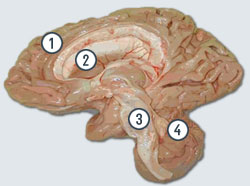The limbic system (in close relationship with the cortex which is the part of the brain that stores our memories) is essential for memorization, learning and emotional behavior of the individual.
What about motor skills?
Movement control involves a hierarchical and interrelated network comprising:
- the motor area of the frontal lobe;
- the basal ganglia located inside the cerebral hemispheres;
- the brainstem;
- the cerebellum.
Profile of the right half of a human brain
Source: Douglas Mental Health University Institute (Montreal, Canada).
1. Motor area
- Constitutes the highest level of the network (in direct relation with the basal ganglia, the cerebellum and the brainstem)
- Initiates muscle activation (unconscious voluntary movements)
- Controls very precise conscious voluntary movements of the hands and fingers (acts directly with the spinal cord)
- Primary role in learning various motor skills
2. The basal ganglia (invisible on the photo)
- Closely related to the motor area
- Regulates tone and adjusts unconscious voluntary movements by modulating their power and direction
- Helps perform complex movements
- Contribute to the acquisition of motor skills
3. Brainstem
- Connects the brain to the spinal cord
- Ensures the body tone necessary for standing
- Involved in the control of eye and facial movements
- Intervenes in physiological regulations (breathing, blood pressure, etc.)
4. The cerebellum (from the Latin cerebellum meaning ‘little brain’)
- Closely related to the motor area and the brainstem
- Modulates and coordinates voluntary movements initiated by the motor area so that they are performed correctly (especially rapid movements)
- Role in maintaining balance and posture
- Role in the learning and acquisition of various motor skills
This network (and in particular the basal ganglia) is involved not only in the control of motor skills but also in the learning and acquisition of motor skills: for example, kicking a ball, shifting gears, using a spoon, etc.
We will say that this network is involved in the functioning of the so- called implicit memory.
Implicit memory is opposed to explicit memory (or declarative memory) involving the limbic system and calling on particular events.
To summarize :
Implicit memory = “know-how motor”
memory Explicit memory = “intellectual know-how” memory
Unlike explicit memory, implicit memory is preserved during normal brain aging as well as in people with Alzheimer’s disease.
On the other hand, it is disturbed in certain diseases caused by the destruction of the central gray nuclei (such as Huntington’s disease or Parkinson’s disease).

